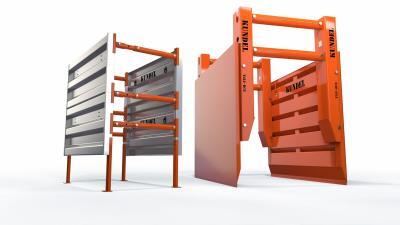What is Cross Boring?
Cross boring refers to the unintentional intersection or crossing of two or more underground utility lines, typically involving a gas line and another utility line, such as a sewer or water line. It occurs when a new utility installation, such as a gas line, is drilled or installed through an existing utility, resulting in the unintended intersection of the two lines. Cross bores can also occur when utilities are installed using trenchless techniques, such as horizontal directional drilling.
Cross bores can pose significant safety risks and potential hazards, particularly when a gas line intersects with a sewer line. The main concern is the potential for gas leaks into the sewer system, which can result in the accumulation of explosive or flammable gasses in confined spaces like buildings or underground structures.
Key Points to Understand About Cross Bores:
- Causes: Cross bores can occur due to factors such as inadequate utility mapping or outdated records, insufficient coordination between utility companies, errors in utility locating, lack of awareness during construction, or the use of trenchless installation techniques without proper precautions.
- Risks and Hazards: The intersection of a gas line with a sewer line poses several risks and hazards, including:
- Gas Migration: Gas leaks can occur through the intersected sewer line, leading to the migration of explosive or flammable gasses into nearby structures.
- Fire and Explosion Hazards: The presence of flammable gasses in confined spaces can create a high risk of fire or explosion if ignited, posing a threat to life and property.
- Inhalation of Toxic Gasses: Cross bores can also result in the release of toxic gasses into the sewer system, which can pose health risks to workers or individuals in the vicinity.
- Prevention and Detection: Preventing cross bores requires a combination of proper utility mapping and identification, improved communication and coordination between utility companies, adherence to industry best practices and regulations, and the use of advanced technologies for utility locating and inspection. Techniques such as video inspection and sonar detection can be employed to identify existing cross bores and mitigate potential risks.
- Regulatory Measures: Regulatory bodies, such as utility commissions or local authorities, may have specific guidelines or regulations in place to address cross bore prevention and mitigation. These regulations may include requirements for utility locators, construction practices, record keeping, inspection protocols, and reporting of cross bores.
- Education and Training: Training programs and awareness campaigns play a crucial role in educating utility workers, contractors, and the public about the risks associated with cross bores and the importance of proper utility identification, reporting, and prevention.
Cross bores are a serious concern in underground utility operations, particularly in the context of gas lines intersecting with sewer lines. Utility companies, contractors, and regulatory bodies must work together to implement robust prevention measures, improve utility mapping and identification practices, and raise awareness about the potential hazards of cross bores to ensure the safety of communities and the integrity of underground utility systems.
Preventing cross bores requires a proactive approach that combines proper planning, coordination, and adherence to industry best practices.
Key Measures for Preventing Cross Bores:
- Utility Mapping and Identification: Accurate and up-to-date utility mapping is essential to identify the location of existing underground utilities. Utility companies should maintain detailed records of their infrastructure and regularly update them as new installations or changes occur. Utilizing technologies such as geographic information systems (GIS) can help improve mapping accuracy.
- Pre-Construction Surveys: Before any excavation or installation work, a thorough pre-construction survey should be conducted to identify the presence of underground utilities in the proposed work area. This can involve using utility locators, ground-penetrating radar (GPR), or other non-destructive techniques to detect and mark the locations of existing utilities.
- Improved Communication and Coordination: Effective communication and coordination between utility companies, contractors, and construction teams are crucial to prevent cross bores. All parties involved should share information about planned excavation or installation activities and coordinate to avoid conflicts with existing utilities.
- Verification and Clearance Process: Before commencing new utility installations, a verification and clearance process should be implemented. This involves visually inspecting the work area, rechecking utility locations, and ensuring there are no conflicts or intersecting utilities. This step helps identify potential cross bore risks and allows for necessary adjustments in the installation plan.
- Trenchless Technology Best Practices: If trenchless installation methods, such as horizontal directional drilling (HDD), are used, specific best practices should be followed. This includes employing guidance systems and surveying techniques to accurately track the drilling path and avoid intersecting existing utilities. Regular inspection and monitoring during the installation process are essential to detect any inadvertent cross bores and take immediate corrective action.
- Training and Education: Providing comprehensive training to utility workers, contractors, and construction crews is essential to raise awareness about cross bore risks and prevention measures. Training should cover proper utility identification, safe excavation practices, reporting procedures for suspected cross bores, and emergency response protocols in the event of a cross bore incident.
- Regulatory Compliance: Compliance with relevant regulations, guidelines, and standards is crucial for preventing cross bores. Utility companies and contractors should familiarize themselves with applicable local, regional, and national regulations regarding utility installations, excavation practices, and cross bore prevention. This may include obtaining permits, following specific construction codes, and complying with reporting requirements.
- Regular Inspections and Maintenance: Ongoing inspections and maintenance of underground utilities are essential for identifying potential cross bores that may have gone unnoticed during initial installations. Regular inspection programs, such as video inspections or sonar detection, can help detect cross bores and other defects in the system and allow for timely repairs or corrective actions.
Preventing cross bores requires a multi-faceted approach that involves careful planning, thorough communication, adherence to best practices, and continuous monitoring. By implementing these preventive measures, the risks associated with cross bores can be minimized, ensuring the safety and integrity of underground utility systems.


